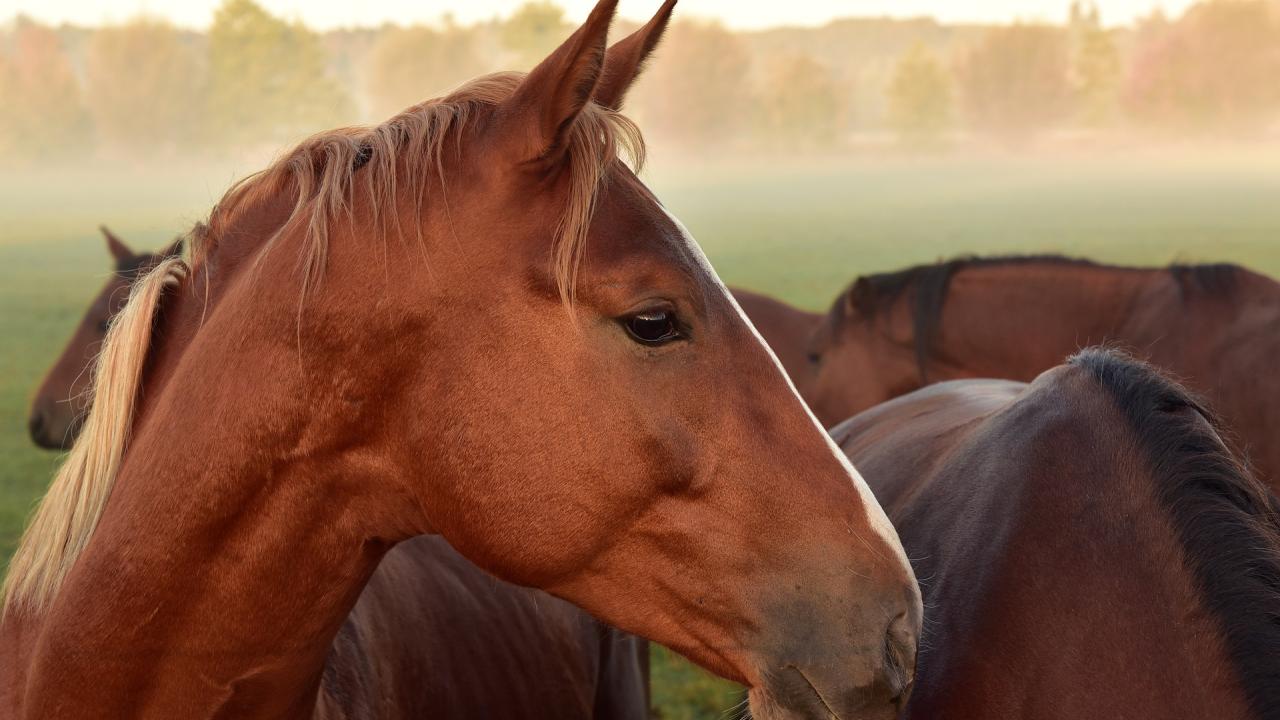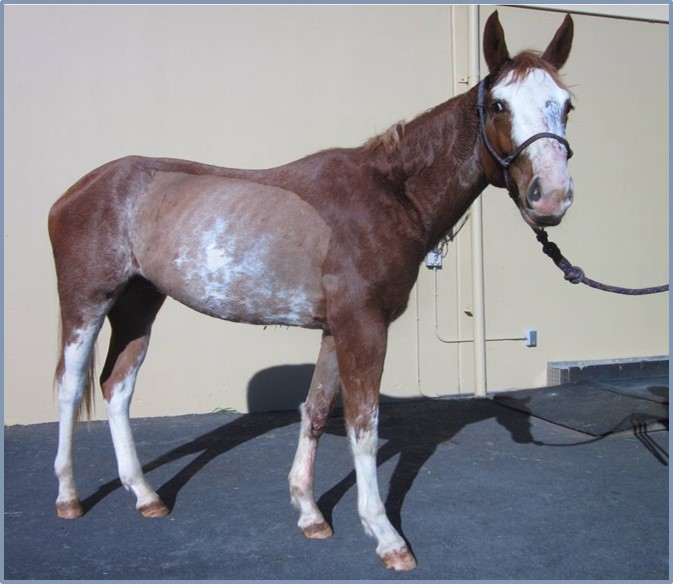
MYH1 Myopathy: Immune-Mediated Myositis / Nonexertional Rhabdomyolysis
What is MYH1 Myopathy (MYHM)?
Takeaways
- MYH1 Myopathy (MYHM) has two clinical presentations;
- Immune mediated myositis (IMM), an autoimmune disease characterized by rapid onset of muscle atrophy (wasting) along the topline and hindquarters
- Nonexertional rhabdomyolysis, or “tying up”, characterized by severe muscle damage without signs of muscle atrophy.
- Quarter Horses and related breeds are affected and a genetic test for the causative MYH1 mutation is available.
- MYHM has an autosomal dominant mode of inheritance with variable penetrance, meaning that not all horses with the mutation will develop the disease.
MYHM is a new term that is used to describe two muscle diseases caused by a mutation in the MYH1 gene; 1) Immune mediated myositis (IMM) and 2) Nonexertional rhabdomyolysis.
What is immune-mediated myositis?
Immune-mediated myositis (IMM) is an autoimmune disease that causes rapid onset of muscle atrophy (wasting) along the topline and hindquarters. This can result in the loss of 40% of muscle mass within 48 hours that can persist for months. The disease has been identified in Quarter Horses and related breeds. Affected horses are usually <8 years of age or >17 years of age. Treatment with corticosteroids can halt the muscle atrophy and may be combined with antibiotics if an infection is present. Muscle mass may recover without treatment within 2-3 months. Horses are fed a diet containing high quality protein and balanced vitamins and minerals during the recovery period. Recurrence of muscle atrophy may require additional corticosteroid therapy.


What is nonexertional rhabdomyolysis?
Nonexertional rhabdomyolysis, or “tying up not caused by exercise”, is characterized by severe muscle pain, stiffness and reluctance to move. Horses can lie down and have difficulty rising due to severe muscle pain. The urine may be brown in color and blood tests show high serum creatine kinase (CK) activity. Some horses with the MYH1 mutation develop this form of muscle damage without showing any muscle atrophy. It occurs most commonly in young horses and can be very severe with serum CK activity > 100,000 U/L. Treatment with dantrolene and corticosteroids can decrease muscle damage. Horses with nonexertional rhabdomyolysis can recover, however, they can go on to have more episodes or develop IMM.
Risk factors for MYHM
Whether or not horses develop IMM or nonexertional rhabdomyolysis depends upon their genetic makeup and the environment. About 39% of MYHM horses have a history of exposure to a triggering factor such as Streptococcus equi subsp. equi infection or exposure, respiratory virus infection, Pigeon fever, or vaccination with Influenza, Equine Herpes Virus 4 or Streptococcus equi subsp. equi.
Researchers at UC Davis and Michigan State University identified a genetic mutation in the Myosin Heavy Chain 1 (MYH1) gene that is associated with increased susceptibility to develop IMM and nonexertional rhabdomyolysis. The MYH1 mutation has an autosomal dominant mode of inheritance, with homozygotes seeming to have more severe signs and more recurrence of muscle disease than heterozygotes. Both males and females are affected. The MYH1 mutation has variable penetrance, meaning not all horses with the mutation develop disease. The specific percentage that do develop disease is not known at this time. The prevalence of the MYH1 mutation in the general Quarter Horse population is estimated to be 7%. The mutation prevalence in Quarter Horse stallions is higher in reining (24%), working cow (17%) and halter (16%) horses, and to date has not been observed in barrel and racing Quarter Horse stallions.
How is MYHM diagnosed?
A genetic test for the MYH1 mutation can be used to assist with the diagnosis of IMM or nonexertional rhabdomyolysis. Until the discovery of the genetic test, a muscle biopsy was performed. Horses with IMM have clinical signs of atrophy, moderate increases in serum CK activity and lymphocytes in their muscle biopsies. The cause of nonexertional rhabdomyolysis in young Quarter Horses was unknown until the discovery of the genetic test because their muscle biopsies had few, if any, abnormalities. The genetic test for MYH1 was a real breakthrough in finding the cause for nonexertional rhabdomyolysis. The MYH1 genetic test is available through the UC Davis Veterinary Genetics Laboratory.
What is the prognosis for MYHM?
Horses can make a full recovery from IMM or nonexertional rhabdomyolysis, but almost 50% will experience recurrent episodes of muscle atrophy or tying up that is not associated with exercise. In severe cases, decreased quality of life may warrant euthanasia. The sooner an affected horse receives treatment, the better the chance for recovery. Homozygous horses have more frequent and severe episodes than heterozygous horses.
How can MYHM be prevented?
Breeders can avoid producing affected offspring by utilizing the available genetic test to identify breeding animals that have 1 or 2 copies of the mutation and using that information to inform breeding decisions. Testing is recommended for Quarter Horses, Quarter Horse crosses, and related breeds.
For more information:
UC Davis Veterinary Genetics Laboratory Myosin-Heavy Chain Myopathy (MYHM) DNA testing
Valberg SJ, Henry ML, Perumbakkam S, Gardner KL, Finno CJ. 2018. An E321G MYH1 mutation is strongly associated with nonexertional rhabdomyolysis in Quarter Horses. J Vet Int Med 32(5):1718-1725.
Gianino, GM, Valberg SJ, Perumbakkam S, Henry ML, Gardner KL, Penedo C, Finno CJ. 2019. Prevalence of the E321G MYH1 variant for immune-mediated myositis and non-exertional rhabdomyolysis in performance subgroups of American Quarter Horses. J Vet Intern Med. 33(2):897-901.
Valberg, S. J., Schultz, A. E., Finno, C. J., Bellone, R. R., Hughes, S. S. 2022. Prevalence of clinical signs and factors impacting expression of myosin heavy chain myopathy in Quarter Horse-related breeds with the MYH1E321G mutation. J Vet Intern Med, 1152-1159.
UC Davis School of Veterinary Medicine statement about IMM testing
*This article may not be reproduced without the written consent of the UC Davis Center for Equine Health. Please email requests to cehadmin@ucdavis.edu.
